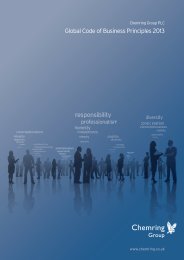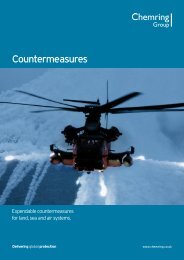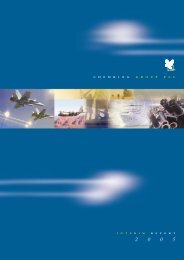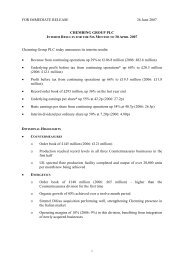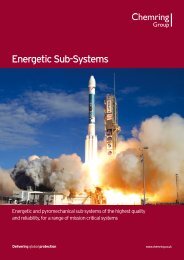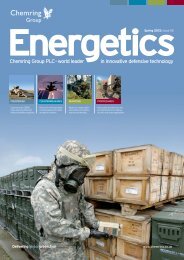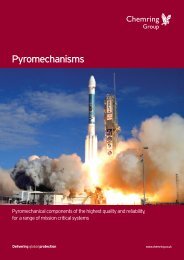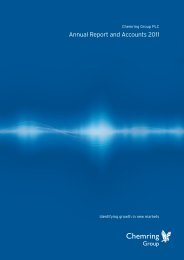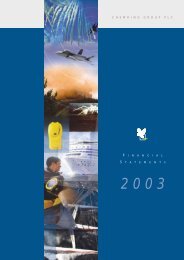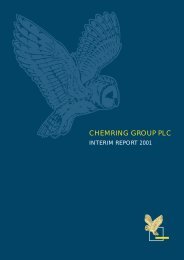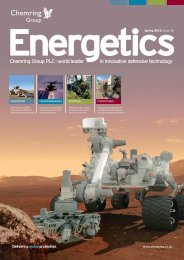Chemring Interim 2006 - Chemring Group PLC
Chemring Interim 2006 - Chemring Group PLC
Chemring Interim 2006 - Chemring Group PLC
You also want an ePaper? Increase the reach of your titles
YUMPU automatically turns print PDFs into web optimized ePapers that Google loves.
C H E M R I N G G R O U P P L CNotes to the <strong>Interim</strong> Statement- continued1. ACCOUNTING POLICIES - continuedRevenue recognitionSales comprise the fair value of the consideration received or receivable for deliveries made, work completed or servicesrendered during the year, net of discounts,VAT and other sales related taxes. Sales are recognised when title passes, or whenthe right to consideration, in exchange for performance, has been completed. For bill and hold arrangements revenue isrecognised when the risks and rewards are transferred to the customer, typically on formal acceptance. An appropriateproportion of total long term contract value, based on the fair value of work performed, is included in revenue and anappropriate level of profit is taken based on the percentage completion method when the final outcome can be reliablyassessed. Provision is made in full for foreseeable losses as soon as they are identified.AcquisitionsOn acquisition of a subsidiary the cost is measured as the fair value of the consideration given plus any directly attributablecosts. The assets, liabilities and contingent liabilities of a subsidiary that meet the IFRS3 Business Combinations recognitioncriteria are measured at the fair value at the date of acquisition. Where cost exceeds fair value of the net assets acquired thedifference is recorded as goodwill.Where the fair value of the net assets exceeds the cost, the difference is recorded directly in the income statement.The accounting policies of subsidiaries are changed where necessary to be consistent with those of the <strong>Group</strong>.Intangible assetsThe purchased goodwill of the <strong>Group</strong> is regarded as having an indefinite useful economic life and, in accordance withIAS36 Impairment of Assets, is not amortised but is subject to annual tests for impairment. In reviewing the carrying valueof goodwill of the various businesses, the Board has considered the separate plans and cash flows of these businesses consistentwith the requirements of IAS36, and is satisfied that these demonstrate that no impairment has occurred. Goodwill arising onacquisition before the date of transition to IFRS has been retained at the previous UK GAAP amounts subject to being testedfor impairment at that date.Expenditure on research activities is recognised as an expense in the period in which it is incurred. Costs incurred indevelopment where the related expenditure is separately identifiable, measurable and management are satisfied as to theultimate technical and commercial viability of the project, and that it is probable that the asset will generate future economicbenefits, are recognised as an intangible asset and amortised on a straight-line basis over typically three years from the date thatcommercial production commences. Development costs not meeting the criteria for capitalisation are expensed as incurred.Patent and trademarks are measured initially at purchase cost and are amortised on a straight-line basis over their estimateduseful lives.For acquisitions after 1 November 2004 the <strong>Group</strong> recognises separately from goodwill intangible assets that are separable orarise from contractual or other legal rights and whose fair value can be measured reliably. These intangible assets have finitelives and are amortised on a straight-line basis over those lives, typically seven years.Property, plant and equipmentOther than revalued land and buildings, property, plant and equipment are held at cost less accumulated depreciation and anyrecognised impairment loss. No depreciation is provided on freehold land. On other assets depreciation is provided at ratescalculated to write down their cost or valuation to their estimated residual values by equal instalments over their estimateduseful economic lives, which are considered to be:Freehold buildings - up to 50 yearsLeasehold buildings - the period of the leasePlant and equipment - up to 10 yearsImpairment of non-current assetsAssets that have indefinite lives are tested for impairment annually. Assets that are subject to depreciation or amortisation arereviewed for impairment whenever changes in circumstances indicate that the carrying value may not be recoverable. To theextent that the carrying value exceeds the recoverable amount an impairment loss is recorded for the difference as an expensein the income statement. The recoverable amount used for impairment testing is the higher of the value in use and its fairvalue less costs of disposal. For the purpose of impairment testing assets are grouped at the lowest levels for which there areseparately identifiable cash flows.P 12



